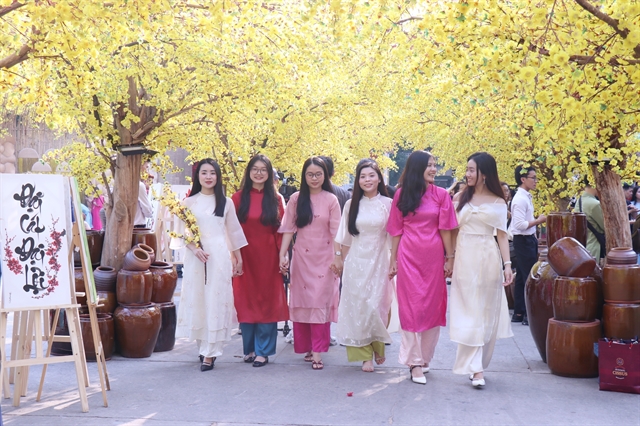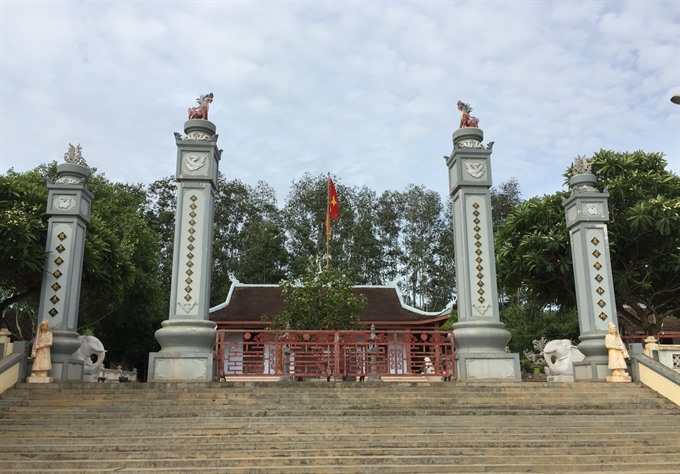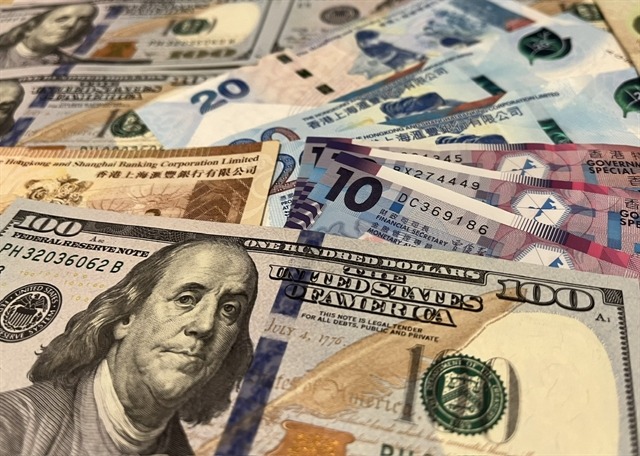

Back in the days of French rule in Việt Nam, some farmers decided to fight against colonialism.
They rose up at a place where there were three houses, which gave the name to their uprising: Ba Đình.
 |
| Welcome: The entrance gate to Vạc Village’s temple.VNS Photo Trần Mai Hưởng |
Back in the days of French rule in Việt Nam, some farmers decided to fight against colonialism.
They rose up at a place where there were three houses, which gave the name to their uprising: Ba Đình.
The fighters attacked the French from these houses, which were surrounded by water and forests.
The French had many more guns than the farmers but the farmers fought long and hard.
Today, they are not only remembered in the area of their base, where the three houses stood, but also in the capital city.
There is a Ba Đình Square in Hà Nội.
By Trần Mai Hưởng
Sơn District in the central province of Thanh Hóa still has traces of the Ba Đình guerrilla base among villages weaving sedge mats, familiar to many generations.
The name Ba Đình has become an important part of the history of the area.
The Ba Đình Uprising took place in 1886-87 under the command of Đinh Công Tráng, Phạm Bành and Hoàng Bật Đạt, gathering local patriotic farmers to fight against French colonialism.
In response to the call of the Cần Vương (Save the King) Movement, the insurgents built a defence base in the territory of three villages, namely Thượng Thọ, Mậu Thịnh and Nghĩa Khê.
In each village, there is a communal house; from each communal house, one can see the other two communal houses.
The name Ba Đình (Three Communal Houses) stems from this area. The insurgents built a strong defence system with deep moats surrounded by forests of bamboo. Each communal house was built as an independent defence post and can support the others [communal houses] in fighting. Military experts assessed the Ba Đình base a model of large-scale defence system of the then Cần Vương Movement.
From the base, under the command of General Đinh Công Tráng and his assistants, the insurgents launched many assaults against the French, controlled local traffic routes, destroyed many vehicles and inflicted heavy casualties to the enemy.
By the end of 1886, French authorities sent thousands of soldiers with heavy weapons to attack the Ba Đình base. Despite being outgunned, the insurgents fought bravely for 32 days and nights.
The Ba Đình Uprising is a historical symbol in the country’s history, representing the patriotism of Vietnamese insurgents in the Nga Sơn region at that time.
According to historical documents, in the middle of 1945 the then Hà Nội’s Mayor, Dr Trần Văn Lai, renamed Puginier Square (name of a French priest) near the former French Governor Palace as Ba Đình Square.
A few months later, after the success of the August 18 Revolution, Ba Đình Square became an important venue in history, where President Hồ Chí Minh read the Declaration of Independence on September 2, announcing the birth of the Democratic Republic of Việt Nam.
In present Nga Sơn District, life has changed. The living standards of local residents have improved, new houses have been built and fertile land nurtures bumper crops.
More than 130 years have passed since poor farmers dared to fight for the homeland’s independence. Present Ba Đình Commune has been enlarged, with bigger houses and good infrastructure facilities.
What’s left of the old Ba Đình Base, a national historical relic site, is a stone stele in the Ba Đình Junior High School.
Local authorities have drafted a plan to upgrade the relic site.
I think Ba Đình deserves a solemn relic site to record the historic event with great value.
A small part of the total amount approved for a ceremony to celebrate the birth of Thanh Hóa Province, expected to reach VNĐ104 billion (US$4.5 million), should be used to preserve the Ba Đình historical relic.
The celebrations is planned for between May 1 and 7, 2019. VNS
GLOSSARY
Nga Sơn District in the central province of Thanh Hóa still has traces of the Ba Đình guerrilla base among villages weaving sedge mats, familiar to many generations.
Traces are small remains.
A guerrilla base is a camp for soldiers who fight as guerrillas. Guerrillas mix with people in the countries where they are fighting and do not operate like old fashioned, formal armies.
Sedge is a type of grass.
The Ba Đình Uprising took place in 1886-87 under the command of Đinh Công Tráng, Phạm Bành and Hoàng Bật Đạt, gathering local patriotic farmers to fight against French colonialism.
To be patriotic means to be loyal to your country.
Colonialism is a system of government that involves a foreign power ruling over a country and taking things from that country to make it rich as well as sending its people to settle there.
In response to the call of the Cần Vương (Save the King) Movement, the insurgents built a defence base in the territory of three villages, namely Thượng Thọ, Mậu Thịnh and Nghĩa Khê.
In response means “replying”.
Insurgents are guerrillas.
In each village, there is a communal house; from each communal house, one can see the other two communal houses.
A communal house is one that a number of people share.
The insurgents built a strong defence system with deep moats surrounded by forests of bamboo.
Moats are canals that run around a protected area or building.
If bamboo forests surround the moats they are all around the moats. In other words, to reach the moats you would have to first pass through bamboo forests.
Each communal house was built as an independent defence post and can support the others [communal houses] in fighting.
An independent defence post is one that does not need help from another post to keep going.
Military experts assessed the Ba Đình base as a model of large-scale defence system of the then Cần Vương Movement.
To assess something means to take a careful look at it and work out what it is about.
From the base, under the command of General Đinh Công Tráng and his assistants, the insurgents launched many assaults against the French, controlled local traffic routes, destroyed many vehicles and inflicted heavy casualties to the enemy.
Assaults are attacks.
Inflicted means caused.
Casualties are deaths or injuries.
A few months later, after the success of the August 18 Revolution, Ba Đình Square became an important venue in history, where President Hồ Chí Minh read the Declaration of Independence on September 2, announcing the birth of the Democratic Republic of Việt Nam.
A venue is a place where some sort of performance or event happens.
In present Nga Sơn District, life has changed. The living standards of local residents have improved, new houses have been built and fertile land nurtures bumper crops.
To nurture a crop means to care for it as it grows.
Bumper crops are very good crops in which lots of food is grown.
More than 130 years have passed since poor farmers dared to fight for the homeland’s independence.
To dare to do something means to decide to do something that is very risky.
Present Ba Đình Commune has been enlarged, with bigger houses and good infrastructure facilities.
Enlarged means “made bigger”.
Infrastructure means roads, railways, telephone lines and other things that are needed to make a place work.
What’s left of the old Ba Đình Base, a national historical relic site, is a stone stele in the Ba Đình Junior High School.
A relic is something left over from long ago.
A stele is a monument
Local authorities have drafted a plan to upgrade the relic site.
To upgrade the site means to make it better and more modern.
I think Ba Đình deserves a solemn relic site to record the historic event with great value.
A small part of the total amount approved for a ceremony to celebrate the birth of Thanh Hóa Province, expected to reach VNĐ104 billion (US$4.5 million), should be used to preserve the Ba Đình historical relic.
If Ba Đình deserves a solemn relic site it is worthy of one.
Solemn means serious.
To preserve something means to keep it in the same food condition that it once was in.
WORKSHEET
Find words that mean the following:
ANSWERS: 1. School; 2. Priest; 3. Mayor; 4. Bamboo; 5. Nights.






.jpg)


